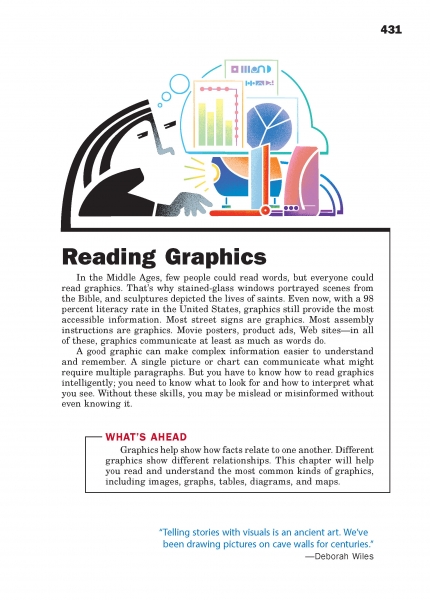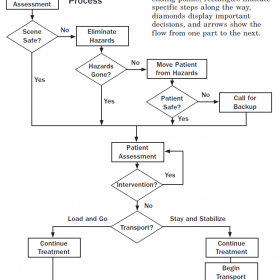Page 431 from

Start-Up Activity
Present students with this definition:
Graphics: Pictures of thinking
Ask students whether they agree with this definition.
In essence, it points out that what we see in person is reality, and everything else is a graphic that allows us to think of things that aren't in front of us. Photos, videos, TV shows, paintings, drawings, charts, diagrams, flowcharts—all of these are pictures of thinking. They visually present someone else's thoughts.
As a result, students should not treat graphics as reality, simply letting the images flow into them. Instead, they should read graphics actively and critically. This chapter provides practice with closely reading many graphic forms.
Think About It
“The human mind grasps the world—even the most abstract, ethereal concepts—as a space filled with movable things and stuff. We say that John went from being sick to being well, even if he didn't move an inch. . . . Mary can give him many pieces of advice, even if they merely talked on the phone and nothing changed hands. Even scientists, when they try to grasp abstract mathematical relationships, plot them in graphs that show them as two- and three-dimensional shapes. Our capacity for abstract thought has co-opted the coordinate system and inventory of objects made available by a well-developed visual system.”
—Steven Pinker

Start-Up Activity
Present students with this definition:
Graphics: Pictures of thinking
Ask students whether they agree with this definition.
In essence, it points out that what we see in person is reality, and everything else is a graphic that allows us to think of things that aren't in front of us. Photos, videos, TV shows, paintings, drawings, charts, diagrams, flowcharts—all of these are pictures of thinking. They visually present someone else's thoughts.
As a result, students should not treat graphics as reality, simply letting the images flow into them. Instead, they should read graphics actively and critically. This chapter provides practice with closely reading many graphic forms.
Think About It
“The human mind grasps the world—even the most abstract, ethereal concepts—as a space filled with movable things and stuff. We say that John went from being sick to being well, even if he didn't move an inch. . . . Mary can give him many pieces of advice, even if they merely talked on the phone and nothing changed hands. Even scientists, when they try to grasp abstract mathematical relationships, plot them in graphs that show them as two- and three-dimensional shapes. Our capacity for abstract thought has co-opted the coordinate system and inventory of objects made available by a well-developed visual system.”
—Steven Pinker



